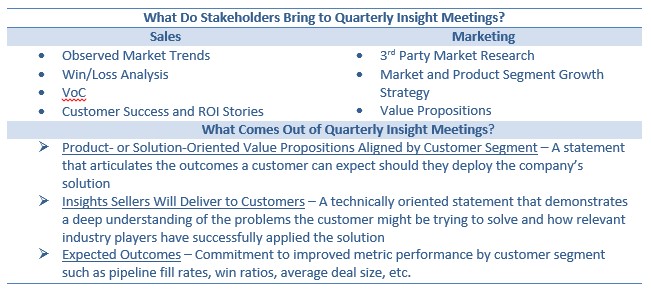Sales Operations – the oil in the insight engine

What happens when you start an engine without oil? It sputters, smokes and eventually stops. If you’re driving your sales force to adopt an insight-led selling approach, don’t try to start it without adding the oil — Sales Operations.
A hot topic among sales executives right now is the shift to Insight-led sales. This means when sellers engage with customers, not only do they demonstrate an accurate and deep understanding of the customer’s business, but they also share insights on the industry — the market — and more importantly, how their solution will deliver positive outcomes for the customer’s business.
Sales Operations is a way to use Insight-led sales to your sales organization’s advantage. This article will discuss Sales Operations and how your organization can use this resource to achieve growth.
Understanding the Insight Engine
Sales leaders tell us the challenges faced when moving to insight-led selling include:
- Getting Sales and Marketing to collaborate effectively to source insights
- Collecting, packaging and curating insights to make them easily accessible to sales reps
- Coaching sales reps to adopt and deliver insights to customers
They also tell us that the key to overcoming these challenges is building a highly functioning “Engine” – a systematic way to enable sales reps with insights that help them win more often, increase average deal size and develop loyal customer followings. These Insight Engines source, package and deliver relevant insights to sellers.
The Insight Engine is not a tool or piece of software. Instead, it’s a process and a business discipline. The engine requires the smooth coordination of two components, namely Sales and Marketing. The engine features a regular cadence of meetings (e.g., quarterly) where Sales and Marketing stakeholders collaborate to develop the insights sellers need to grow pipelines, win more often and increase average deal size. Sales stakeholders include senior leadership and first- and second-line sales managers collaborating with strategic and product marketing stakeholders.
Research participants tell us Sales Operations must act as the oil to keep the Insight Engine running. Without the discipline and execution capabilities of a strong Sales Operations function, the Insight Engine quickly breaks down, like so many failed sales improvement efforts that went before it.
What Is Sales Operations?
Sales Operations is a set of strategies, processes and tools that support the sales organization in pursuit of profitable revenue growth and increased productivity. The Sales Operations process leverages data, technology and tactical functions to position sellers for success. Sales Operations concepts can be used to to build a salesforce, establish sales procedures and analyze sales performance. The ultimate goal of Sales Operations is to transform the sales department into the most efficient and productive version of itself.
How Can Sales Operations Help?
Sales Operations teams typically offer four useful functions:
- Manage the Process – Sales Operations must coordinate and facilitate the regular engagement between Sales, Marketing and Service/Customer Success. The Sales Operations leader has the right charter to run regular meetings, document insights and coordinate action steps.
- Facilitate Insight Harvesting – They work with the Sales organization to bring together learnings from Win/Loss analysis, customer success stories and field tests. They champion the importance of harvesting and sharing insights, and thoughtfully leverage SPIFFs and recognition programs to support this effort.
- Facilitate Insight Packaging and Delivery to the Field – Sales Operations works with Marketing to inform insight codification, management and dissemination. They select the channels to deliver the insights to sellers including, but not limited to, training programs, field management coaching, sales meetings, email, CRM or a number of other tools and communication vehicles.
- Track and Measure Impact – Sales Operations collects feedback on the impact of insights. They track and measure results to help improve the process and the quality and effectiveness of the Insight Engine. Based on this feedback Marketing can effectively curate the portfolio of insights for usage, removing underperforming and outdated insights and refreshing with new points of view. The continual refreshing of the Insight Engine is critical to keep the field engaged and motivated to use insights on an ongoing basis.
Challenges Faced by Sales Operations
The demands placed on Sales Operations have changed. Sales Ops teams need a clear path to operate at their full potential. Rise above reactive, tactical problems to tackle the bigger charter of sales ROI. This requires strategic and structural change.
Today’s Sales Operations teams face the following challenges:
- Unclear charter for the scope and objectives, rendering it stuck in the daily grind of tactical administrative “break/fix” problem solving
- Undefined roles in Sales Operations resulting in lack of focus and more reactive activity
- Lack of a clear annual planning process delaying implementation of critical programs like sales motions, territories, quotas and sales compensation
- Untracked sales investments on tools, training and support resources leaving future investment decisions based on status quo rather than impact and ROI
- Disconnect from business strategy and go-to-market priorities that leads to distrust between Sales and Sales Operations
- “Cost center” approach that renders Sales Operations vulnerable to cutbacks and streamlining precisely when more investment may be needed
How to Achieve Sales Growth Through Sales Operations
Revenue and sales leaders are given a growth goal. Then they are presented with product marketing plans. Next, they fuse growth ambitions and product plans into a workable sales strategy. This is where leading Sales Ops groups shine. They provide guidance on where to look for the best sales growth opportunities.
The following three steps ensure organizations pinpoint and capitalize on opportunities for sales growth:
STEP 1: FOCUS ON THE MOST ATTRACTIVE GROWTH OPPORTUNITIES
Sales Ops (often teamed with Marketing) accomplishes this by undertaking two critical analyses:
- Identify industries/sectors that are growing, healthy and most apt to buy “our kind” of products/services
- Identify subsets of these industries where we have a competitive advantage through product differentiation, vertical/application expertise or a deep reference base
This enables high-performing Sales Ops functions to identify sectors with both the highest growth potential and the highest propensity to buy:
In this way Sales Ops provides guidance to focus limited resources on opportunities with the highest potential return.
STEP 2: TURN OPPORTUNITY INTO A SALES STRATEGY
In each target sector, accounts must be identified, categorized and prioritized. The best Sales Ops functions don’t leave this to chance. Top Sales Ops functions identify accounts by sector, region, district and territory. They provide sellers with a list of target accounts and contacts. And they fit these accounts into one of four categories:
Sellers can steer away from the lower left quadrant to focus more effort on higher value accounts. And they can tailor their message and approach according to whether the account is a current client, a target, or has a high or low sales potential.
STEP 3: SUPPORT THAT ENABLES MORE WINS
This is the nitty-gritty aspect of ensuring that sellers have the ammunition they need to win on the ground. This includes services like:
- Populating CRM systems with contact information
- Tracking down success stories and producing high-powered cases
- Maintaining a list of customer references
- Maintaining a library of applications and solutions relevant to each target sector
- Maintaining an up-to-date list of solution/application experts who can be called upon for help and advice
- Working with Marketing to build and distribute first-rate sales collateral that sellers actually use
- Collecting and distributing relevant insight from social media about activity in the sector or at specific accounts
- Building playbooks based on seller best practices on what to do and who to call on to maximize the odds of winning, tailored to whether the customer is a current user, light user or a high-value target
Transform Your Organization into a Revenue Leader
To meet customers’ demands, Sales Operations leaders must transform themselves into revenue partners. Sales Operations is uniquely equipped to bring together marketing, sales and service in pursuit of the new revenue growth equation. Their understanding of the sales process, day-to-day interaction with the go-to-customer model, and insight to the data means that Sales Operations leaders can succeed where others cannot through:
- Implementation of marketing strategy by converting high-level objectives into specific segment and account targets
- Translation of product marketing plans into customer-centric value propositions that sellers can actually use
- Enablement of agile coverage with digital platforms that engage customers from marketing through service and can respond rapidly to opportunity and change
- Delivery of consistent customer success by identifying what works and building best practices into the sales coverage cadence
Drive Revenue Growth With Alexander Group
Sales Operations will back your sellers with the support they need to achieve and surpass your organization’s sales goals. You can begin integrating Sales Operations by partnering with Alexander Group. We have decades of experience helping businesses across industries implement the most recent and successful innovations. Contact us today to learn how Alexander Group can help.
